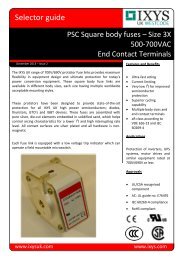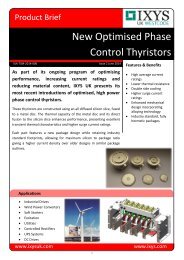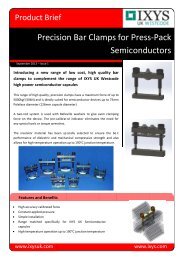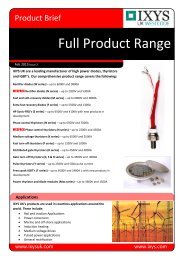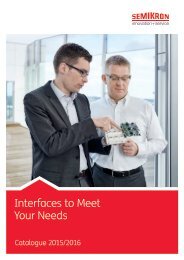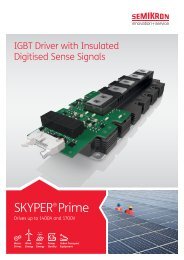isolated current voltage transducers
You also want an ePaper? Increase the reach of your titles
YUMPU automatically turns print PDFs into web optimized ePapers that Google loves.
Glossary A-Z<br />
Open loop <strong>current</strong> <strong>transducers</strong> (§ 3.1)<br />
Current <strong>transducers</strong> where the output signal is an image of the<br />
magnetic field created by the primary <strong>current</strong> to be measured. It<br />
generally uses a magnetic circuit which focuses the field on a field<br />
sensing element, e.g. made of a Hall generator. The output signal is<br />
a direct amplification of the Hall signal, giving a true image of the<br />
measured <strong>current</strong> if the system is designed for a linear behavior.<br />
Primary<br />
The input, driving or measured side of a circuit and the components<br />
related to that side of the circuit. Galvanic isolation is provided<br />
between the primary and the secondary side. For example, the<br />
primary winding carries the primary <strong>current</strong>. See also Secondary.<br />
PWB (printed wiring board)<br />
Often referred to as a „PCB“ or printed circuit, or PWB depending<br />
on the geographic location.<br />
Ratiometric<br />
The output (offset and/or transfer function) is directly proportional to<br />
the supply or a reference <strong>voltage</strong>. See also Offset and Transfer<br />
function.<br />
Reaction time<br />
The delay between the measured signal reaching 10% of final value<br />
and the output signal reaching 10% of final value. See also<br />
Response time, and Rise time (Figure 8).<br />
Recovery time<br />
The time required to ‘recover’ and resume normal operation after an<br />
event that interrupts operation, such as saturation. Not to be<br />
confused with Settling time.<br />
Remanence<br />
After traversing a hysteresis loop the output will not return to zero<br />
when the input is at zero. The amount remaining at the output is the<br />
remanence and, in essence, creates an additional output offset.<br />
See also Magnetic offset and Hysteresis.<br />
It is minimized by design in LEM <strong>transducers</strong> and is often resulting<br />
from a non-expected primary <strong>current</strong> overload. The magnetic offset<br />
defines the offset on the transducer output signal, positive or<br />
negative depending on the direction of the <strong>current</strong> overload.<br />
Response time<br />
The time difference between the driving signal reaching 90% of its<br />
final value and the measured signal reaching 90% of its final value.<br />
This is a combination of delay time, driving signal rise time, and<br />
measured signal rise time. See also Reaction time and Rise time<br />
(Figure 8).<br />
Rise time<br />
The time difference between a signal reaching 10% and 90% of its<br />
final value. See also Delay time, Reaction time, and Response time<br />
difference (Figure 8).<br />
Saturable inductor<br />
An inductor designed to operate into its saturation region. The<br />
inductance value varies from a high value at low <strong>current</strong>s (based on<br />
the permeability of the core) to a low value at high <strong>current</strong>s (the<br />
core permeability becomes unity when saturated). (Figure 25).<br />
Secondary<br />
The output, driven or measurement side of an <strong>isolated</strong> circuit and<br />
the components related to that side of the circuit. Isolation is<br />
provided between primary and secondary side components. For<br />
example, the secondary supply provides secondary compensation<br />
<strong>current</strong>. See also Primary.<br />
Settling time<br />
The amount of time required to ‘settle’ to within a defined tolerance<br />
after a disturbance, such as dv/dt. Not to be confused with<br />
Recovery time.<br />
Standard Fluxgate<br />
A LEM definition, Standard Fluxgate <strong>transducers</strong> operate on the<br />
closed loop principle and provide the most „standard“ performance<br />
in term of accuracy or bandwidth. Non-standard Fluxgate<br />
<strong>transducers</strong> include the more efficient IT or C-types, or the less<br />
dynamic „low frequency“ Fluxgates. See also C-type, IT-type,<br />
Fluxgate, Low frequency Fluxgate and § 4.<br />
Transfer function<br />
The ratio of output signal to input signal. For example, if a 100A<br />
input creates a 1V output the transfer function is 1V / 100A or 1mV /<br />
100mA. The output of a ratiometric device is dependent on the<br />
supply <strong>voltage</strong>, so VS will be part of the transfer function.<br />
Turns ratio<br />
The ratio of primary turns to secondary turns in a transformer. With<br />
closed loop <strong>current</strong> <strong>transducers</strong>, the turns ratio typically assumes a<br />
single primary turn. For example, 1:1000 implies 1000 secondary<br />
turns and a secondary <strong>current</strong> of 1mA with a single primary turn<br />
carrying 1A.<br />
47






